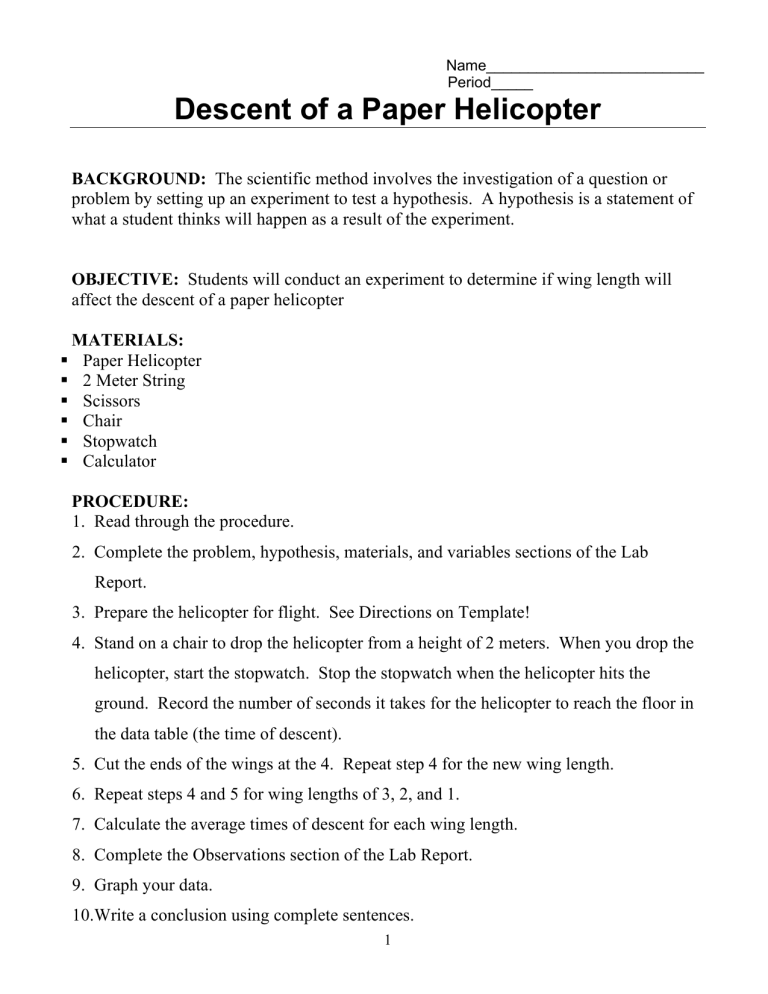Paper Helicopter Descent Lab Report: Wing Length Experiment
advertisement

Name__________________________ Period_____ Descent of a Paper Helicopter BACKGROUND: The scientific method involves the investigation of a question or problem by setting up an experiment to test a hypothesis. A hypothesis is a statement of what a student thinks will happen as a result of the experiment. OBJECTIVE: Students will conduct an experiment to determine if wing length will affect the descent of a paper helicopter MATERIALS: § Paper Helicopter § 2 Meter String § Scissors § Chair § Stopwatch § Calculator PROCEDURE: 1. Read through the procedure. 2. Complete the problem, hypothesis, materials, and variables sections of the Lab Report. 3. Prepare the helicopter for flight. See Directions on Template! 4. Stand on a chair to drop the helicopter from a height of 2 meters. When you drop the helicopter, start the stopwatch. Stop the stopwatch when the helicopter hits the ground. Record the number of seconds it takes for the helicopter to reach the floor in the data table (the time of descent). 5. Cut the ends of the wings at the 4. Repeat step 4 for the new wing length. 6. Repeat steps 4 and 5 for wing lengths of 3, 2, and 1. 7. Calculate the average times of descent for each wing length. 8. Complete the Observations section of the Lab Report. 9. Graph your data. 10.Write a conclusion using complete sentences. 1 Descent of a Paper Helicopter—Lab Report DAY #1 PROBLEM/QUESTION (what you investigated in your experiment): HYPOTHESIS (a single sentence explaining what you think will happen between the variables in the experiment): Remember (If/Then/Because) MATERIALS (list the materials you will use to perform the experiment): VARIABLES: a) Independent (Manipulated) (what you will be changing): b) Dependent (Responding) (what will respond to the change): c) Control (what must remain the same): DESCRIPTION OF EXPERIMENT (one or two sentences describing your experiment): DATA: Number of Seconds for each Descent Wing Length Trial 1 Trial 2 5 4 3 2 1 2 Trial 3 Mean of Trials OBSERVATIONS (difficulties with or knowledge gained during your experiment, or modifications to your procedure): DATA ANALYSIS: Graph your data. Be sure to label your axes, use a consistent interval, and title your graph. Graph the independent variable on the x-axis and the dependent variable on the y-axis. 3 CONCLUSION: 1.Restate the problem or question. 2.Briefly describe your experiment. 3.Summarize the data from your experiments. 4.Compare your data to your hypothesis: Does your data support your hypothesis? Why or why not? 5.Discuss what you learned. 6.Problems/Improvements: What problems did you have with the lab? If you did this lab again, what would you do differently? 4 Name______________________ Period______ Follow-Up to Descent of a Paper Helicopter DAY #2 1) What other factors influence the flight of a paper helicopter? Factor #1: Factor #2: Factor #3: 2) Describe an experiment you could do to test one of the factors you listed in #1. Write a problem statement, the variables (independent and dependent), a hypothesis, an outline of a procedure. A.) Problem: B.) Hypothesis: C.) Independent Variable: D.) Dependent Variable: E.) Controls: F.) Procedures: 5 Number of Seconds for each Descent Trial 1 Trial 2 Trial 3 Mean of Trials DATA ANALYSIS: Graph your data. Be sure to label your axes, use a consistent interval, and title your graph. Graph the independent variable on the x-axis and the dependent variable on the y-axis. 6 CONCLUSION: 1. Restate the problem or question. 2. Briefly describe your experiment. 3. Summarize the data from your experiments. 4. Compare your data to your hypothesis: Does your data support your hypothesis? Why or why not? 5. Discuss what you learned. 6. Problems/Improvements: What problems did you have with the lab? If you did this lab again, what would you do differently? 7 PAPER HELICOPTER DIRECTIONS: 1. Cut along the solid lines of the template. 2. Fold along the dotted lines. The propeller blades should be folded in opposite directions. X and Y fold toward the center, and Z is folded up to give the body rigidity and to lower the center of gravity. 3. Stand up and drop the helicopter. Your helicopter is complete! 8 PAPER HELICOPTER TEMPLATE DAY #1 DAY #2 5 4 3 2 1 9

